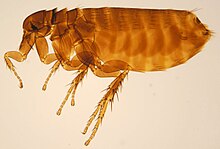Chicken flea
| Ceratophyllus gallinae | |
|---|---|
 |
|
| Female hen flea | |
| Scientific classification | |
| Kingdom: | Animalia |
| Phylum: | Arthropoda |
| Class: | Insecta |
| Order: | Siphonaptera |
| Family: | Ceratophyllidae |
| Genus: | Ceratophyllus |
| Species: | C. gallinae |
| Binomial name | |
|
Ceratophyllus gallinae (Schrank, 1803) |
|
Ceratophyllus gallinae, known as the hen flea in Europe or the European chicken flea elsewhere, is an ectoparasite of birds. This flea was first described by the German botanist and entomologist Franz von Paula Schrank in 1803.
Ceratophyllus gallinae was first described as Pulex gallinae by Franz von Paula Schrank in 1803 in the third volume of his Fauna Boica. It was eventually moved to the genus Ceratophyllus, which was described in 1832 by John Curtis, in his British Entomology. In this genus, C. gallinae is a member of the nominate subgenus, Ceratophyllus.
This flea is estimated to occupy a range of 36,000,000 square kilometres (14,000,000 sq mi).
The adult Ceratophyllus gallinae is some 2 to 2.5 mm (0.08 to 0.10 in) long, laterally flattened, and brown. It has a pair of simple eyes, a proboscis for sucking blood, and a characteristic four to six bristles on the femur of the hind leg. The basal segments of the legs do not bear spines.
Ceratophyllus gallinae has a broad host range, being associated with several species of birds with dry cavity or semi-cavity nests, mostly constructed in bushes and trees. It commonly attacks poultry, and can bite humans and other mammals. Another bird flea, C. garei, is associated with the often wet, ground-built nests of ducks, waders and other water birds. A third common bird flea, found on many hosts, is the moorhen flea, and this, in contrast to the other two species, hitches a ride on the bird itself rather than living almost exclusively in its nest, and thus becomes widely dispersed. A further species with multiple bird hosts is C. borealis, found in the nests of passerines and cliff-nesting sea birds. C. borealis has been known to hybridise with C. gallinae.
...
Wikipedia
